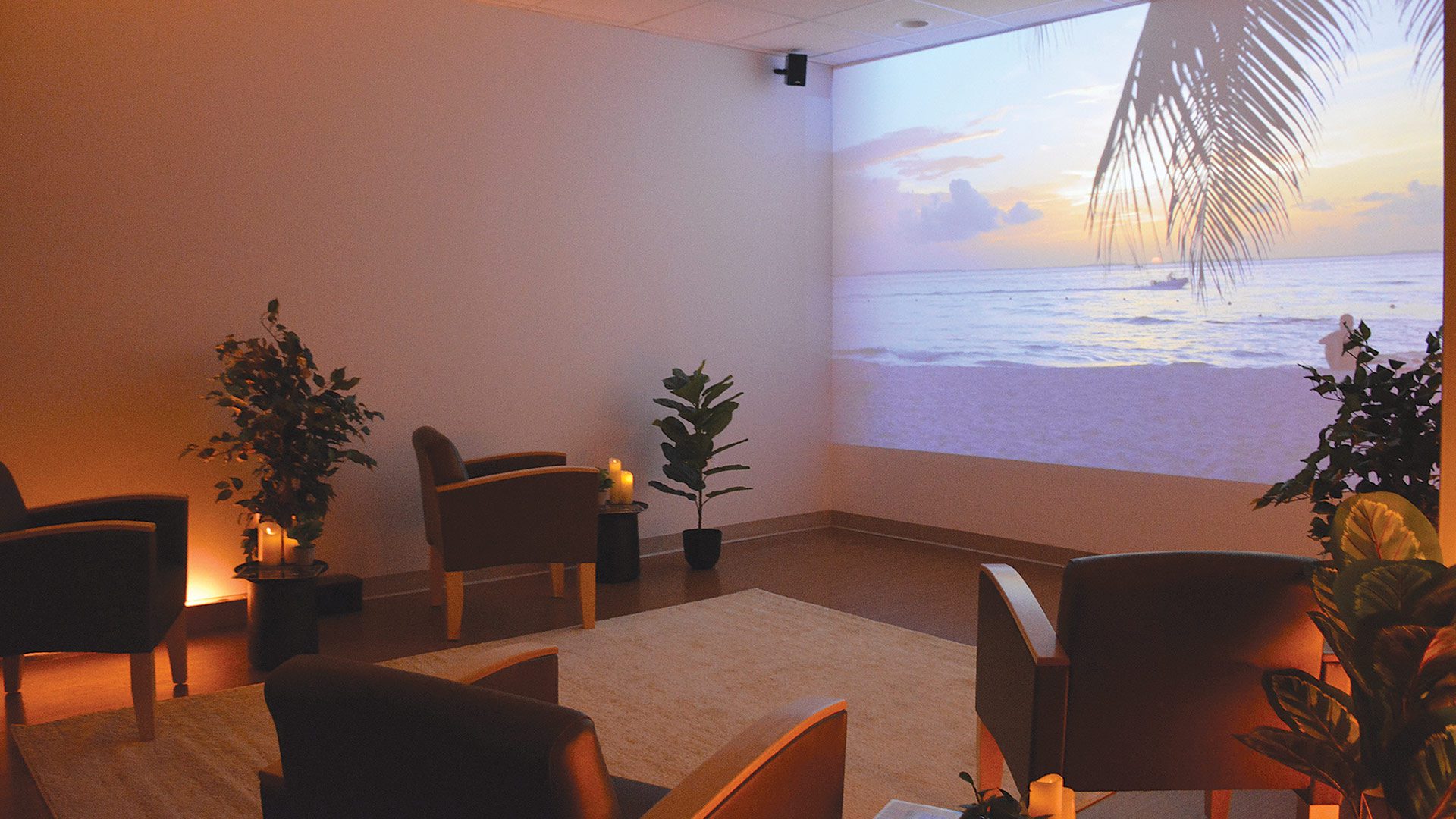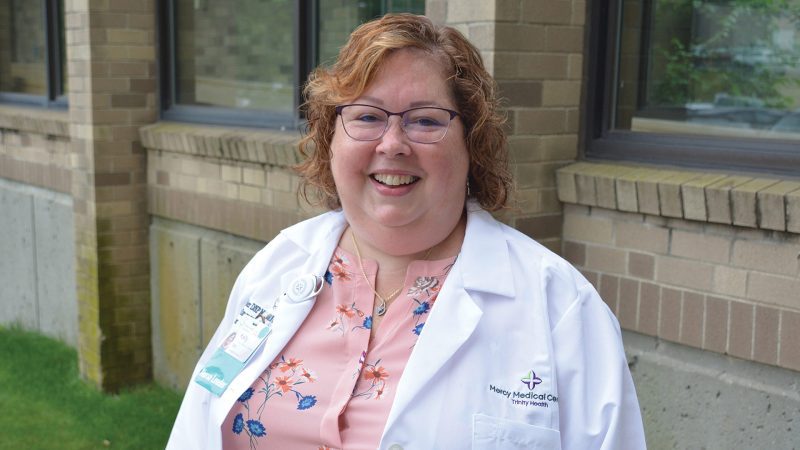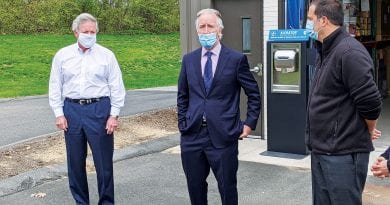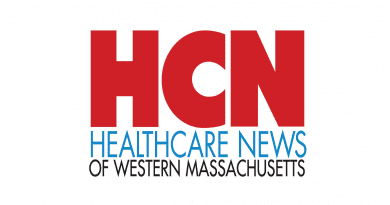Hospitals Take Creative Steps to Attract and Retain Nurses
Support Systems

Kelly Chevalier, DND, is a military veteran, having served in the Air National Guard at Barnes Airport in Westfield.
She said there have been many comparisons between actual combat and day-to-day life in hospitals and other healthcare settings at the height of COVID. She believes they are valid.
Recalling those days, Chevalier, director of Nursing Education at Mercy Medical Center and director of the Emergency Department, said healthcare professionals would show up for work facing a great unknown and danger to their own health and safety.
“That made me proud to be a part of this career and proud to be a nurse,” she said, comparing the nurses she worked beside to soldiers going into battle. “They showed up when a lot of people didn’t want to.”
But while most nurses did, indeed, show up, combatting COVID and its many side effects has taken its toll — on both the nursing profession locally and everywhere, and on facilities trying to maintain a full staff of nurses.
As Chevalier and others told HCN, COVID prompted many nurses who were at or near retirement age to take that step and leave the profession behind. And for some not near retirement, the COVID fight and a desire not to endanger the health of loved ones prompted them to look at other career options, with many eventually finding opportunities elsewhere.

This dramatically altered landscape has left area hospitals scrambling to fill their nursing ranks, often resorting to the hiring of very expensive travel nurses, individuals willing, as that name suggests, to travel (sometimes long distances) to take nursing positions at different kinds of facilities.
In the wake of COVID, but in some cases before it arrived, hospitals have been taking steps to more effectively attract and retain nurses and create work environments that help them confront the stress and strain of everyday work. Such initiatives range from signing bonuses and generous wages to ‘appreciation meals’ and so-called ‘quiet rooms.’
Spiros Hatiras, president and CEO of Holyoke Medical Center (HMC), said his institution has put in place generous sign-on bonuses and other initiatives, steps that were in place long before COVID, to not only bring nurses to HMC but draw people into the nursing profession.
“From day one, I’ve implemented, one of, if not the most generous education benefits in the valley, to help people go back to school and advance their degrees,” he explained. “The last element is reaching out to new grads, but we need to make it so we offer something they can’t say ‘no’ to. We’ve decided to offer each new grad nurse $50,000 when they sign on with us, check in hand, as long as they sign to work with us for four years.”
Not only do new nurses get a bonus, but already employed nurses can receive an additional $20,000 to their annual income if they agree to work with Holyoke Medical Center for another five years.

“From day one, I’ve implemented, one of, if not the most generous education benefits in the valley, to help people go back to school and advance their degrees.”
For this issue and its focus on healthcare, BusinessWest looks at the current landscape in nursing and how area hospitals are working to address the many ongoing challenges they, and their nurses, are facing.
Supply and Demand
The challenge of securing adequate numbers of nurses is nothing new for area hospitals. With the aging of the Baby Boom generation, matching the number of retirements with new hires has been a difficult assignment.
And COVID, and the so-called Great Resignation, have only exacerbated the problem. Indeed, according to Nursing Solutions Inc., the national healthcare retention and registered nurse (RN) staffing report of 2021 said that for the first time ever, retirement is one of the top three reasons for resignations among registered nurses.
This phenomenon has created what Joanne Miller, chief nurse executive, Baystate Health and chief nursing officer, Baystate Medical Center, called an ‘experience gap.’
“The experience of the complexity gap has widened,” she explained. “Meaning the nursing workforce experience has dropped and the complex care that patients need today is rising. So the overall growth of an RN workforce is primarily new graduates.”
Contending with this gap is just one of the challenges facing hospitals, said those we spoke with, adding that COVID pushed more nurses into retirement and other professions, while it inspired others to join the ranks of travel nurses, and, in doing so, earn much more than they were making.

“We’re investing in and learning more about the antidote to fatigue and burnout — that is the ability for our nurses to become resilient. In order to identify and address stress, we’re creating an environment where we can openly share and discuss these feelings.”
“We had a large group of nurses that jumped on the travel nurse wave,” said Chevalier, adding that for many in the profession, the chance to earn the wages being offered by travel-nurse agencies was an opportunity they could not pass on.
Hatiras agreed.
“Some people don’t mind traveling and bouncing around from facility to facility and seeing the country,” he noted. “Because of the shortage, the amount of money these agencies were offering nurses to do that was incredibly high, so more nurses left regular full-time jobs to do that. It’s a supply-and-demand issue.”
All three hospitals we spoke with have been working hard to increase the number of staff available on their floors, many of which are again operating at or near full capacity as COVID cases wane.
One way that facilities are combating the issue of staffing is moving staff to areas where the help is needed most and make greater use of certified nursing assistants (CNAs).
“Before, we only had a few (CNAs) on the floor,” said Hatiras. “There were only two nurses and four CNAs on the floor. Now, we’ve teamed up every nurse with a CNA and they work as a team. It’s a one-to-one ratio, and it has helped out a lot,” said Hatiras.
CNAs are able to assist nurses by fulfilling tasks that don’t require a nursing license, such as gathering supplies and medications, documenting important information, assisting in procedures, and transporting patients.
Each facility has its own kind of float pool to help nurses in other areas of the hospital. Nurses are able to volunteer to be moved to other areas that need more assistance, said Hatiras, stressing the importance of volunteering; moving nurses from a unit they enjoy can cause “a lot of dissatisfaction.”
Hospitals are also taking steps to improve the pipeline of nurses from area colleges through various programs designed to only provide experience but introduce them to the institutions in the hope that they will stay with a hospital after they graduate from college.
Baystate and Mercy have partnerships with colleges in the region whereby nurses are able to join an internship program, known as clinicals, and can have a paid position with the facility.
“It’s a great opportunity to be exposed to nursing from an ancillary level with some infusion of higher level of learning from a registered nurse’s perspective,” said Chevalier. “It’s a great way for us to pick from the best of the best that’s out there and really make sure they’re not just an academic good fit, but a cultural good fit.”
Miller told HCN that one step taken at Baystate was to hire 39 student nurses from a Student Nurse Association Program (SNAP) to help further their learning at Baystate Medical Center. The program provides experience for the student nurses and introduces them to Baystate — and the job opportunities there. “They’re not nurses yet, but they’re in college,” she explained. “They do this outside of their clinical practicum. In their junior or senior year of college, a student is able to get a job at the local hospital, practicing and learning since we know they’re in a nursing program; we show them the ropes a little bit more. It’s a great experience for a nursing student.”
“Some people don’t mind traveling and bouncing around from facility to facility and seeing the country. Because of the shortage, the amount of money these agencies were offering nurses to do that was incredibly high, so more nurses left regular full-time jobs to do that. It’s a supply-and-demand issue.”
Meanwhile, hospitals are taking steps to improve the overall experience for nurses, through initiatives like quiet rooms, or what Mercy calls ‘zen rooms.’
Quiet rooms are specifically designed to have minimal noise, allowing nurses a welcome break from the stress of an average day. Nurses are encouraged to practice breathing techniques, meditate, and decompress while in these rooms. Most rooms even include a massage chair and minimal-interaction videos.
“We’re investing in and learning more about the antidote to fatigue and burnout — that is the ability for our nurses to become resilient,” said Miller, noting that Baystate has created eight quiet rooms for its nursing staff. “In order to identify and address stress, we’re creating an environment where we can openly share and discuss these feelings. It is very important to be able to do that. We’re working to promote and include self-care in their everyday lives.”
Space and quiet aren’t the only way hospitals in the area are making their nursing staff feel appreciated. Facilities are raising the bar when it comes to ongoing work to keep their nurses motivated and wanting to work.
“It’s a struggle to find fun things to do to keep people engaged and excited and interested that don’t tax our resources,” said Chevalier, adding that Mercy continues to look for ways to support its nurses.
Care Package
Facilities also offer smaller incentives such as food truck events, family and friend picnics, and an extra week of vacation to help nurses relax.
Mercy Medical Center has come up with the ‘comfort cart’ — the executive team travels the entire hospital with a car filled with snacks and “trinkets of appreciation,” said Chevalier.
A popular favorite at area hospitals has been meals and appreciation picnics with the families. Hatiras said his staff’s most popular pick is Chick-Fil-A meals.
Taking such steps is just one way hospitals are addressing a problem that began well before the pandemic but has been put into new perspective by what are challenging and truly unprecedented times.




